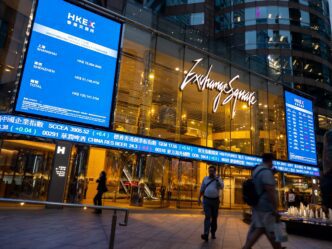Executive Summary
- Global financial markets saw a significant uplift after the U.S. government shutdown, which lasted 40 days, was officially resolved following the advancement of a reopening measure in the U.S. Senate.
- This resolution occurred after eight Democratic senators voted alongside Republicans, securing its passage.
- Despite the closure’s immense economic toll on the U.S. economy, market sentiment reacted positively, causing global shares, U.S. Treasury yields, and the dollar to rally, while central banks assess their monetary policy outlook.
The Story So Far
- Global financial markets reacted positively to the official end of the U.S. government shutdown, which lasted 40 days and caused significant economic strain. The resolution, secured after the U.S. Senate advanced a measure to fund federal agencies, confirmed the reopening of the government following President Donald Trump’s signature.
Why This Matters
- The end of the record-long U.S. government shutdown triggered an immediate and significant rally across global financial markets, including stocks, U.S. Treasury yields, and the dollar, reflecting a surge in investor confidence. However, despite this positive market reaction, the prolonged closure has already left a “growth dent” on the U.S. economy, with analysts cautioning that its full economic ramifications, such as potential negative Q4 GDP, will persist and require continued vigilance.
Who Thinks What?
- The U.S. Senate advanced a measure to fund the government, securing the resolution to the 40-day shutdown.
- Global financial markets and analysts reacted with optimism to the news of the end of the shutdown, leading to market rallies, but cautioned that economic ramifications would likely persist.
- White House economic adviser Kevin Hassett warned that the nation’s fourth-quarter GDP could turn negative if the government shutdown continued.
Global financial markets saw a significant uplift on Monday following optimistic signals that the protracted U.S. government shutdown, now in its 40th day, was nearing an end. The U.S. Senate advanced a measure aimed at reopening federal agencies, prompting a rally in global shares, a rise in U.S. Treasury yields, and a recovery for the dollar after previous losses.
U.S. Shutdown Resolution
Global financial markets saw a significant uplift on Monday following the resolution of the protracted U.S. government shutdown, which lasted 40 days. The U.S. Senate advanced a measure that successfully reopened federal agencies, prompting a rally in global shares, a rise in U.S. Treasury yields, and a recovery for the dollar after previous losses.
The measure passed with eight Democratic senators voting alongside Republicans to fund the government until January 30. This legislative package, which includes three full-year appropriations bills, signaled the end of the longest government shutdown in U.S. history. The government is now fully reopened following President Donald Trump’s signature.
Economic Impact and Market Reaction
The shutdown exerted a growing toll on the U.S. economy, resulting in unpaid federal workers across various sectors, delays in essential services like food aid, and disruptions to air travel. White House economic adviser Kevin Hassett warned that the nation’s fourth-quarter GDP could turn negative if the impasse had continued.
Market sentiment reacted positively to the news. Nasdaq futures climbed 1.27%, while S&P 500 futures rose 0.74%. European markets also surged, with EUROSTOXX 50 and DAX futures jumping approximately 1.5% each, and FTSE futures gaining 0.85%.
Across Asia, MSCI’s broadest index of Asia-Pacific shares outside Japan advanced 1.36%, and Japan’s Nikkei 225 index saw a 1.33% increase. In China, the CSI300 blue-chip index reversed earlier losses to trade 0.3% higher, and Hong Kong’s Hang Seng Index rose 1.5%.
China’s Economic Landscape
Supporting regional optimism, data released on Sunday indicated an easing of producer price deflation in China for October, with consumer prices returning to positive territory. These figures suggest a degree of stability as the Chinese government continues efforts to address over-capacity and intense competition within its industries.
Currencies, Yields, and Central Bank Outlook
U.S. Treasury yields edged higher, with the benchmark 10-year yield increasing by over 4 basis points to 4.1355%, and the two-year yield rising approximately 3.8 basis points to 3.5949%. The dollar regained some ground against major currencies as investors assessed the U.S. economic outlook against a backdrop of a more hawkish Federal Reserve.
Despite recent data raising concerns about a weakening U.S. labor market, several Fed officials last week reiterated a preference for a cautious approach to further rate cuts. Markets are currently pricing in a 63% chance of a Fed rate cut in December, though some economists suggest the decision remains contingent on incoming data and risk assessment.
The dollar also strengthened against the yen, rising 0.33% to 153.96. Meanwhile, Bank of Japan policymakers discussed the growing case for raising interest rates in the near term, focusing on sustaining wage-hike momentum.
Commodity Markets
In commodity markets, oil prices saw an uptick, with Brent crude futures gaining 0.83% to $64.15 per barrel and U.S. crude rising 0.92% to $60.31. Spot gold also increased, up 1.9% to $4,074.81 an ounce.
Market Outlook
The end of the record-long U.S. government shutdown has significantly boosted market confidence. However, analysts caution that the economic ramifications of the longest shutdown in U.S. history will likely persist. The resolution, though market-friendly, does not fully undo the growth dent caused by the prolonged federal closure, indicating that cautious optimism remains for the immediate future.







